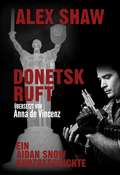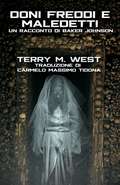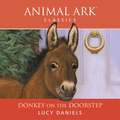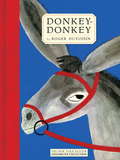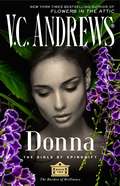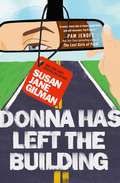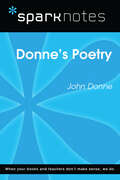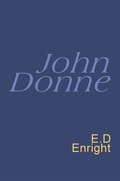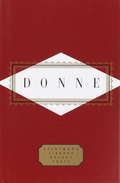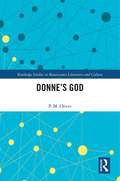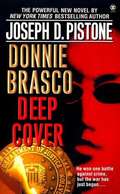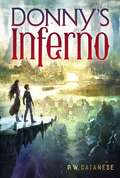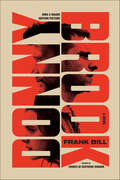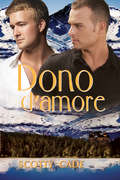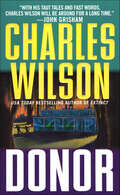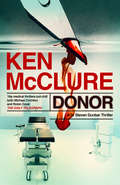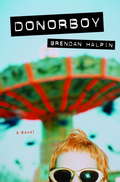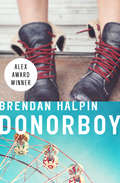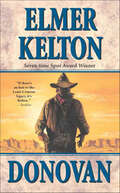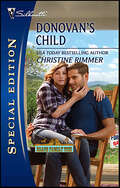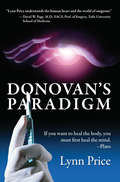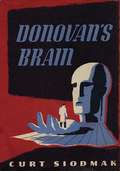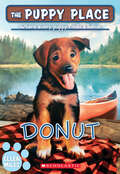- Table View
- List View
Donetsk Ruft
by Alex Shaw Anna De VincenzDer ehemalige SAS-Soldat, jetzt MI6 Agent Aidan Schnee kehrt in einer Kurzgeschichte zurück. Als ein Expat hat Brian Webb ein tolles Leben, eine sexy Frau und eine perfekte Tochter. Aber all dies wird in Gefahr gebracht, als er auf dem Weg nach Hause nach einer durchzechten Nacht von einer Gruppe bewaffneter Angreifer gejagte wird. Wer sind seine Verfolger, was wollen sie von ihm, und warum schießen sie? Webb will lieber nicht bleiebn um dies herauszufinden. Ein gestohlenes Auto wird zu Schrott gefahren beim Versuch zu entkommen und Webb wird blutig geschlagen, in die Enge getrieben und hat keine Optionen mehr... ohne eine andere Wahl, ruft er die einzige Person an, die ihn nie im Stich lassen würde. Er ruft Aidan Snow an. In Kiew angekommen, nimmt Snow das Gesetz in die eigene Hand in einem Versuch einen seiner ältesten Freunde zu finden und zu retten. Mit den Geistern der Vergangenheit auf seinen Schultern muss Snow sich wieder auf seinen SAS Training verlassen und wird nicht aufhören , bis er die Wahrheit erfährt.
Doni freddi e maledetti: Un racconto di Baker Johnson
by Terry M. WestDoni freddi e maledetti è un’inquietante racconto dello scrittore horror acclamato dalla critica Terry M. West. Baker Johnson è un viziato parapsicologo nell’anno 1925. Dopo la morte di Richard Johnson, Baker eredita le proprietà di suo zio e trasloca nella casa del leggendario ricercatore psichico. Ma presto scopre che la Stanza Nera della proprietà, il luogo in cui sono messi al sicuro gli oggetti infestati, è stata svuotata.
Donkey on the Doorstep (Animal Ark #12)
by Ben M. BaglioAndi doesn't want to give up her donkey, Dorian, but her family is moving into a smaller house and there's no room for him. Dorian, however, has other ideas! Can Mandy and James help their stubborn old friend?
Donkey on the Doorstep (Animal Ark #12)
by Lucy DanielsAndi doesn't want to give up her donkey, Dorian, but her family is moving into a smaller house and there's no room for him. Dorian, however, has other ideas! Can Mandy and James help their stubborn old friend?(P) Hodder Children's Books 1997
Donkey-donkey
by Roger DuvoisinDonkey-donkey has a problem. Despite his many friends and his good master, he is sad because his ears are so long and ridiculous. If only Donkey-donkey could have short sensible ears like his friend Pat the horse, he would be content. So he seeks the advice of his fellow farm animals who suggest he wear his ears differently, more like theirs: floppy like the dog's, to the side like the sheep's, to the front like the pig's. But each unnatural arrangement leads to increasing insult and injury. Finally a little girl passing by remarks on the beauty of the pretty little donkey's ears! At last Donkey-donkey is happy. A classic tale of vanity and folly, and learning to accept oneself--protrudent ears, redundant name, and all.
Donna (The Girls of Spindrift #2)
by V.C. AndrewsBook Two of the Girls of Spindrift. From the New York Times bestselling author of the Flowers in the Attic and My Sweet Audrina series, now Lifetime movies, continues a haunting new series featuring highly intelligent teenage girls who struggle to survive a specialized high school and find their place in a world that doesn&’t understand them. Such is the burden of being brilliant.Being gifted is not something Donna ever wanted. It&’s difficult enough to have a Latino father and Irish mother, and her genius only separates her even more from the other girls. They don&’t say it, but they blame her for everything that goes wrong, just because she&’s different. And on the precise day she tries her hardest to fit in, everything turns out a disaster. A fight breaks out, and somehow Donna ends up in the middle. It&’s not her fault, but it&’s her word against theirs, and this time, the other girls aren&’t going to stay quiet. The only solution might be to escape to the mysterious school her counselor is telling her about: Spindrift. The four Girls of Spindrift novellas together form a spinoff to Bittersweet Dreams—available now!
Donna Has Left the Building
by Susan Jane GilmanFrom the beloved, New York Times-bestselling author of Hypocrite in a Pouffy White Dress comes a hilarious, timely, and big-hearted new novel about rebuilding life in the face of disaster.Forty-five-year-old Donna Koczynski is an ex-punk rocker, a recovering alcoholic, and the mother of two teenagers whose suburban existence detonates when she comes home early from a sales conference in Las Vegas to the surprise of a lifetime. As her world implodes, she sets off on an epic road trip to reclaim everything she believes she's sacrificed since her wild youth: Great friendship, passionate love, and her art. But as she careens across the U.S. from Detroit to New York to Memphis to Nashville, nothing turns out as she imagines. Ultimately, she finds herself resurrected on the other side of the globe, on a remote island embroiled in a crisis far bigger than her own.Irresistibly funny, whip-smart, and surprisingly moving, DONNA HAS LEFT THE BUILDING spins an unforgettable tale about what it means to be brave -- and to truly love -- in a tumultuous world.
Donne's Poetry (SparkNotes Literature Guide Series)
by SparkNotesDonne's Poetry (SparkNotes Literature Guide) by John Donne Making the reading experience fun! Created by Harvard students for students everywhere, SparkNotes is a new breed of study guide: smarter, better, faster.Geared to what today's students need to know, SparkNotes provides:chapter-by-chapter analysis explanations of key themes, motifs, and symbols a review quiz and essay topics Lively and accessible, these guides are perfect for late-night studying and writing papers.
Donne's Religious Writing: A Discourse of Feigned Devotion (Longman Medieval and Renaissance Library)
by P. M. OliverThis, the first book to focus solely on Donne's religious writing, also places his work in a literary context and attempts to reach a more realistic assessment of its originality than has been possible hitherto. The prose works that are examined in detail include the controversial treatises Bianthanatos and Pseudo-Martyr, the satirical Ignatius His Conclave, the much-quoted Essays and Devotions and, of course, Donne's sermons.
Donne: Everyman's Poetry
by John DonneThe best of John Donne's poemsJohn Donne (1572-1631) was born into a Catholic family and studied law before sailing with Essex to attack Cadiz in 1596. He was appointed secretary to Sir Thomas Egerton, the Lord Keeper (later Lord Chancellor), in 1598, but forfeited his worldly prospects when he secretly married Ann More, Lady Egerton's niece, in 1601; he was dismissed by Egerton and briefly imprisoned. The next twelve years or so were passed in poverty, without regular employment. He entered the Church and in 1621 was made Dean of St Paul's, where he became a renowned preacher. His first collection of poems was published posthumously in 1633.
Donne: Poems (Everyman's Library Pocket Poets Series)
by John DonneThe Everyman's Library Pocket Poets hardcover series is popular for its compact size and reasonable price which does not compromise content. Poems: Donne contains Songs and Sonnets, Letters to the Countess of Bedford, The First Anniversary, Holy Sonnets, Divine Poems, excerpts from Paradoxes and Problems, Ignatius His Conclave, The Sermons, Essays and Devotions, and an index of first lines.
Donne’s God (Routledge Studies in Renaissance Literature and Culture)
by P.M. OliverHis contemporaries recognised John Donne (1572-1631) as a completely new kind of poet. He was, wrote one enthusiast, ‘Copernicus in Poetrie’. But in the winter of 1614-15 Donne abandoned part-time versification for full-time priestly ministry, quickly becoming one of the most popular preachers of his time. While his verse has never been short of modern admirers, his sermons have recently begun to receive their full share of serious attention. Yet there exists almost no theologically-informed criticism to assist readers with navigating, let alone appreciating, the intricacies of Donne’s religious thinking. The need for such criticism is especially urgent since many readers approach his writing today with little previous knowledge of Christian doctrine or history. This book supplies that deficiency. Starting from the assumption that theology is inevitably the product of the human imagination, a perception that is traced back to major early Christian writers (and something that Donne implicitly acknowledged), it probes the complex amalgam that constituted his ever-shifting vision of the deity. It examines his theological choices and their impact on his preaching, analysing the latter with reference to its sometimes strained relationship with Christian orthodoxy and the implications of this for any attempt to determine how far Donne may legitimately be viewed as a mouthpiece for the Jacobean and Caroline Church of England. The book argues that the unconventionality that characterises his verse is also on display in his sermons. As a result it presents Donne as a far more creative and risk-taking religious thinker than has previously been recognised, especially by those determined to see him as a paragon of conventional Christian orthodoxy.
Donnie Brasco: Deep Cover
by Joseph D. PistoneFrom the back cover: After almost single-handedly ruining much of the East Coast Mafia, FBI Special Agent Donnie Brasco has become a media star. But the "Family" never forgets. There's an open contract out on his life, worth half a million dollars. And the only way Brasco can survive it is by doing what comes naturally..going deep undercover again. Covering possible political corruption in southern Florida, an FBI agent is in over her head. When Brasco is sent to her rescue, what he finds is one dead agent and a hurricane he barely survives. Posing as her cousin, he follows her leads to the steamy Florida Everglades, where he runs up against a brutal gang of backwoods thugs -- a criminal organization every bit as terrifying as the Mafia wiseguys who put a price on his head.
Donny's Inferno
by P. W. CataneseFrom award-winning author P.W. Catanese comes a fascinating novel about a twelve-year-old boy who must prevent the new kinder, gentler underworld from returning to its previous terrifying incarnation.Twelve-year-old Donny Taylor was rescued from certain death in a burning building. His savior, a mysterious girl named Angela Obscura, seems to be able to walk right out of the flames. Although she appears to be a teenager, Angela is actually an ancient dignitary from the underworld who needs the help of a mortal. And she's chosen Donny. Hades, a bizarre, cavernous world that was once filled with pitchforks, fiery pits, and dismemberments, has recently become a kinder, gentler place where people can contemplate their transgressions rather than face eternal punishment. Now known as Sulfur, the underworld went through a period of reformation punctuated by a violent revolution that left the vicious old guard, the Merciless, defeated and imprisoned. But it soon becomes apparent that the Merciless are plotting a comeback. If they succeed, they will reignite the long-extinguished Pits of Fire with a billion souls inside. And reformers like Angela and Donny will face Annihilation: the utter destruction of the consciousness and the soul, a nothingness more final than death itself. With everything on the line and billions of souls to protect, Donny--a mortal and outsider--becomes the key to the underworld's salvation and the only one who can save Sulfur.
Donnybrook: A Novel
by Frank BillA bareknuckle fighter must win a brutal tournament to feed his family in “a novel that guts the underbelly of southern Indiana”—now a major motion picture (Kirkus Reviews).The Donnybrook is a three-day bare-knuckle tournament held on a thousand-acre plot out in the sticks of southern Indiana. Twenty fighters. One wire-fence ring. Fight until only one man is left standing while a rowdy festival of onlookers—drunk and high on whatever’s on offer—bet on the fighters.Jarhead is a desperate man who’d do just about anything to feed his children. He’s also the toughest fighter in southeastern Kentucky, and he’s convinced that his ticket to a better life is one last fight with a cash prize so big it’ll solve all his problems. But he’ll have to face Chainsaw Angus—an undefeated fighter who recently got into cooking meth with his sister, Liz.As we travel through the backwoods to get to the Donnybrook, we meet a cast of nasty, ruined characters driven to all sorts of evil, all in the name of getting their fix—drugs, violence, sex, money, honor. Donnybrook is exactly the fearless, explosive, amphetamine-fueled debut novel you’d expect from the author of the feted and fearless story collection Crimes in Southern Indiana.
Dono d’amore (Serie amore)
by Scotty Cade Ilaria D'AlimonteLa sera prima del suo matrimonio, Zander Walsh rincasa assieme ai suoi genitori e al suo futuro marito, e vengono tutti massacrati a colpi di arma da fuoco nel corso di una misteriosa rapina. Dopo tre settimane di coma Zander si risveglia per scoprire di essere l'unico sopravvissuto alla strage e la sua vita perfetta va a pezzi in un attimo. L'affascinante agente dell'FBI Jake Elliott è assegnato al caso e finalmente riesce a catturare l'assassino, che però fugge poco dopo. Dopo sei mesi d'indagini, Zander e Jake si accorgono che c'è stato un forte ostruzionismo da parte dell'FBI... e anche che hanno stretto un intenso legame che si sta pian piano trasformando in qualcosa di sempre più importante. Ma quando intraprendono un viaggio per fermare il killer una seconda volta, scoprono che in quella terribile notte non era in corso solo una semplice rapina... riusciranno un grosso affare e la politica a nascondere la verità, o forse la missione di Zander e Jake per svelare il mistero segnerà la fine del loro amore appena sbocciato e delle loro vite?
Donor
by Charles WilsonYoung ER doctor Michael Sims feels too many of his patients are dying without cause. Shannon Donnelly, the Congressman's beautiful daughter, believes the police are wrong in ruling her father's death a suicide. Now they're teaming up uncover the truth about a terrifying medical experiment involving nerve regeneration and organ transplants. It's backed by millions of dollars. It's protected at the highest levels of government. But there are no volunteers, no donors. There are only ordinary people who check into this Mississippi hospital...and discover that death isn't he worst thing they have to fear. Getting "chosen" is....
Donor (The Dr Steven Dunbar Thrillers)
by Ken McClureFirst in the series featuring the ex-Special Forces medic: &“His medical thrillers out-chill both Michael Crichton and Robin Cook.&” —Daily Telegraph When seven-year-old Amanda Chapman is admitted to the hospital with acute renal failure, her parents are in despair. Their hope is renewed when Amanda is accepted for treatment in a pioneering, state-of-the-art dialysis unit in an exclusive private hospital in Glasgow, Scotland. But behind the lavish hospital corridors, private rooms, and friendly staff lies something much more sinister, and Dr. Steven Dunbar must go undercover to find it—and stop it . . .
Donorboy
by Brendan HalpinRosalind had two mommies. Now, thanks to a tragic accident involving foodstuffs, she has none. And Sean, the sperm donor responsible for half her DNA (and nothing else), is taking custody. Rosalind finds herself adjusting to a new life that seems both hateful and surreal-she's an orphan with a new father, surrounded by friends she is beginning to despise and well-meaning adults who succeed only in annoying her. Sean made a donation fifteen years ago, and his life since has not gone according to plan. Thirty-five, single, and still grieving the loss of his own mother twenty-seven years ago, he decides to take on the overwhelming task of caring for an unhappy teenager he doesn't know. Told entirely through e-mail, instant messaging, journal entries, and other random communications, Donorboy is the comic, compellingly readable novel of how these two people learn to converse, cook, write heavy-metal songs, and nail windows shut on their way to becoming a family. Brendan Halpin has written a universal story of how we laugh, cry, and occasionally punch our way to a new life in the face of tragedy. From the Trade Paperback edition.
Donorboy
by Brendan HalpinA novel for secondary school English classes with great writing and important themes.
Donovan
by Elmer KeltonDonovan was supposed to be dead. The town of Dry Fork, southern Texas, had buried him years before when Uncle Joe Vickers had fired off both barrels of a shotgun into the vicious outlaw's face as he was escaping from jail. Now, Uncle Joe has been shot-in just the same way. And Judge Upshaw had found a noose hanging on his door. It looked as though Donovan was back-gunning for the people who had tracked him down and tried him. Sheriff Webb Matlock, a stern, quiet man, had more than one reason to find Donovan; Matlock was in love with the woman he had believed to be Donovan's widow; moreover, there were rumors that his hotheaded younger brother Sandy might have joined up with Donovan's gang. For his own peace of mind, and to protect the townspeople who had been threatened, Matlock decided to slip across the border, find Donovan in his Mexican hideout, and bring him back-or kill him.
Donovan's Child (Bravo Family Ties)
by Christine RimmerHe survived a fall, but he may never recover from a Bravo woman. From the New York Times–bestselling author of Expecting the Boss’s Baby.The first time, it was a tumble down a mountain that threatened Donovan McRae's very survival. And though he had once been the Man Who Had Everything, at that point he thought he had nothing left to lose.Until Abilene Bravo walked into his life—and he realized he was wrong. Because though he thought he'd lost his heart years ago, he found himself losing it again as he fell fast . . . for the feisty woman who wouldn't take no for an answer.
Donovan's Paradigm
by Lynn PriceNew surgeon Kim Donovan runs afoul of lead surgeon Erik Behler when she tries to institute an innovative program that challenges the traditional foundations of medicine. The resulting fallout alters the terrain of their lives and the future of medicine within the hospital.
Donovan’s Brain: Hauser's Memory
by Curt SiodmakThe SF classic novel of the terror that lurked in DONOVAN'S BRAIN.DEAD...Doomed by disease, then mangled in a plane crash, there was no doubt that Donovan was dead.YET...floating in a tank of nutrient, linked to complex apparatus, Donovan's brain still lived...ALIVE...someone walked with Donovan's gait, wrote his signature, knew his foulest secrets--and carried out his last, weirdest plan!"Donovan's Brain is terrific!"--THE NEW YORK TIMES
Donut (The Puppy Place #63)
by Ellen MilesWelcome to the Puppy Place! Where every puppy finds a home.Charles and Lizzie Peterson love puppies. Their family fosters these young dogs, giving them love and proper care, until they can find the perfect forever home.Lizzie's so excited to head up into the country for her Aunt Amanda's sleepaway doggy camp to learn new ways to train dogs. But they're both surprised by the arrival of Donut, a Lab-Shepherd mix puppy who might not join her family on their move. Lizzie will have to use her new skills to show that Donut is sweet and well-trained for her family's new home.
